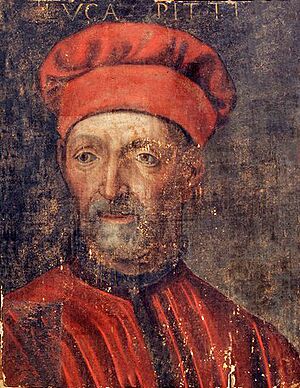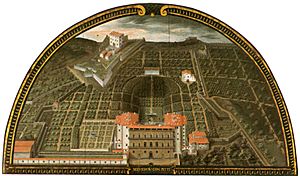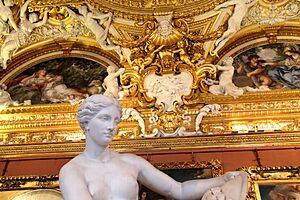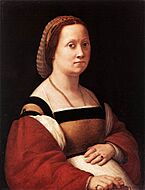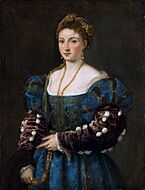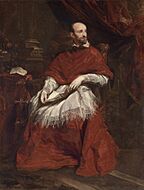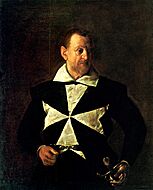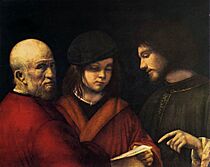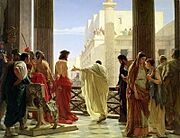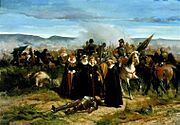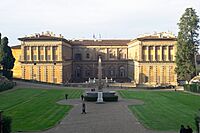Palazzo Pitti facts for kids
The Palazzo Pitti, also known as the Pitti Palace, is a huge palace in Florence, Italy. It's a famous building from the Renaissance period. The palace sits on the south side of the Arno River, not far from the Ponte Vecchio. The main part of the palace was built starting in 1458. It was first the home of Luca Pitti, a rich banker from Florence.
The powerful Medici family bought the palace in 1549. It became the main home for the rulers of Tuscany. Over many years, the palace became a huge treasure house. It collected many paintings, fancy dishes, jewelry, and other valuable items. The Medici family also added the large Boboli Gardens to the palace grounds.
Later, in the late 1700s, Napoleon used the palace as a base during his European conquests. For a short time, it was also the main royal palace for the newly united Italy. This was under the House of Savoy. In 1919, King Victor Emmanuel III gave the palace and its treasures to the Italian people.
Today, the Pitti Palace is the biggest museum complex in Florence. The main palace building is about 32,000 square meters (about 344,000 square feet). It is now divided into several important art galleries and museums.
The Pitti Palace is a key part of the Historic Centre of Florence. This area was named a UNESCO World Heritage Site in 1982. The palace shows off Florence's amazing Renaissance history.
Contents
Palace History
Building the Palace
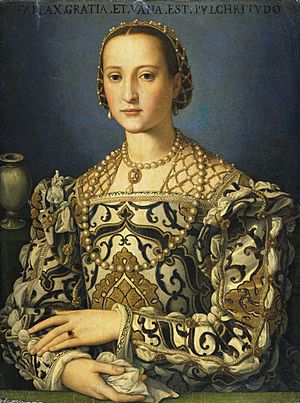
The building of this grand palace began in 1458. It was ordered by Luca Pitti, a Florentine banker. He was a close friend and supporter of Cosimo de' Medici. There are many stories about the early days of the Pitti Palace. Some say Pitti wanted his palace windows to be bigger than the entrance of the Palazzo Medici Riccardi.
The art historian Giorgio Vasari (from the 1500s) believed that Filippo Brunelleschi was the palace's architect. He thought Brunelleschi's student, Luca Fancelli, was just an assistant. But today, most people believe Fancelli was the main architect. Brunelleschi actually died 12 years before the palace construction started.
The palace's design looks very strong and serious. It has rough stone blocks, which gives it a powerful feel. It also has three rows of seven arch-shaped openings, like a Roman aqueduct. This Roman-style look was popular in Florence. Work on the palace stopped after Luca Pitti lost money. This happened after Cosimo de' Medici died in 1464. Luca Pitti passed away in 1472, and the building was still not finished.
The Medici Family Takes Over
In 1549, the palace was sold to Eleonora di Toledo. She grew up in the fancy court of Naples. Eleonora was married to Cosimo I de' Medici, who later became the Grand Duke of Tuscany. When they moved into the palace, Cosimo asked Vasari to make it much bigger. A new section was added to the back, more than doubling its size.
Vasari also built the Vasari Corridor. This was a secret walkway above the ground. It connected Cosimo's old palace, the Palazzo Vecchio, to the Pitti Palace. It went through the Uffizi Gallery and over the Ponte Vecchio. This allowed the Grand Duke and his family to travel safely between their official home and the Pitti Palace.
At first, the Pitti Palace was mainly used for guests and special court events. The Medici family still lived mostly in the Palazzo Vecchio. But later, Cosimo's son Francesco I and his wife Johanna of Austria made the Pitti Palace their permanent home. This is when the Medici art collection moved there.
Land on the Boboli hill behind the palace was bought to create a large formal park. This park is now known as the Boboli Gardens. The first landscape architect was Niccolò Tribolo. After he died, Bartolommeo Ammanati took over. The gardens were designed around an amphitheater behind the palace. Plays were performed there for the Medici court.
Palace Additions and Courtyard
After the gardens were started, Ammanati focused on building a large courtyard behind the main palace front. This connected the palace to its new garden. This courtyard has rough, strong stone work that many later buildings copied. Ammanati also changed the windows on the main front. He added "kneeling" windows, which looked like prayer desks.
From 1558 to 1570, Ammanati built a grand staircase. This led up to the main floor (the piano nobile) with more style. He also extended the wings on the garden side. These wings surrounded a courtyard dug into the hillside. On the garden side of this courtyard, Ammanati built a grotto (a cave-like structure). It was called the "grotto of Moses" because of a statue inside.
Later, in 1616, a competition was held to design extensions to the main front. Giulio Parigi won. Work began in 1618 on the north side and in 1631 on the south side. In the 1700s, two more wings were added. These helped create a large open space in front of the palace, like a grand entrance court.
One side of the gardens has a unique grotto designed by Bernardo Buontalenti. The lower part was started by Vasari. But the upper part has strange "dripping" stone formations. Inside, the first room has copies of Michelangelo's unfinished statues. These statues seem to hold up the ceiling, which is painted like a rustic bower with animals and plants.
Later Rulers and Museums
The Pitti Palace was the main Medici home until Gian Gastone de' Medici, Grand Duke of Tuscany died in 1737. He was the last male Medici ruler. After his sister, Anna Maria Luisa de' Medici, died, the Medici family line ended. The palace then went to the new rulers of Tuscany, the Austrian House of Habsburg-Lorraine.
Napoleon briefly took over the palace when he controlled Italy. When Tuscany became part of the House of Savoy in 1860, the Pitti Palace was included. After Italy became united, Florence was briefly its capital. King Victor Emmanuel II lived in the palace until 1871. His grandson, Victor Emmanuel III, gave the palace to the nation in 1919.
Today, the palace and other buildings in the Boboli Gardens are divided into five art galleries and a museum. They hold many of the original treasures. The 140 rooms open to the public show how the palace looked in the 1600s and 1700s. In 2005, old bathrooms from the 1700s were found in the palace. They had plumbing very similar to what we use today!
Palatine Gallery: Art Treasures
The Palatine Gallery is the main art gallery in the Pitti Palace. It holds over 500 paintings, mostly from the Renaissance. These paintings were once part of the private art collections of the Medici family and the rulers who came after them. The gallery also extends into the royal apartments.
You can see works by famous artists like Raphael, Titian, Perugino, Correggio, Peter Paul Rubens, and Pietro da Cortona. The gallery still feels like a private collection. The artworks are displayed as they would have been in grand rooms, not in a strict timeline or by art school.
The most beautiful rooms were decorated by Pietro da Cortona in the fancy Baroque style. Cortona painted a small room called the Sala della Stufa. He painted a series showing the "Four Ages of Man." These paintings were very popular. He then painted five grand reception rooms, called the Planetary Rooms. These rooms show gods and goddesses in a special order, celebrating the Medici family. Cortona left Florence in 1647, and his student, Ciro Ferri, finished the paintings. These rooms later inspired the Planet Rooms at Louis XIV's Palace of Versailles in France.
The collection was first opened to the public in the late 1700s. This was done by Grand Duke Leopold I, who wanted to be popular after the Medici family's rule ended.
Rooms of the Palatine Gallery
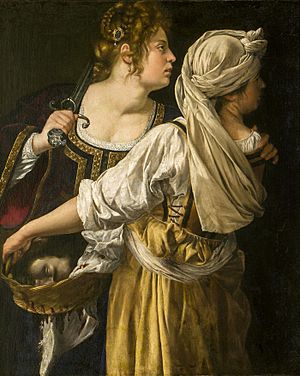
The Palatine Gallery has 28 rooms. Here are some of them:
- Room of Castagnoli: Named after the painter of the ceiling. It has portraits of the Medici and Lorraine families. It also has the Table of the Muses, a beautiful table made with inlaid stones.
- Room of the Ark: Contains a painting by Giovan Battista Caracciolo. The ceiling was painted in 1816 by Luigi Ademollo.
- Room of Psyche: Named after ceiling paintings by Giuseppe Collignon. It has paintings by Salvator Rosa.
- Hall of Poccetti: The ceiling paintings are now thought to be by Matteo Rosselli. In the center is a table from 1716. The hall also has works by Rubens and Pontormo.
- Room of Prometheus: Named after the subject of the paintings by Collignon. It has many round paintings (tondi). These include works by Filippo Lippi, Botticelli, Pontormo, and Domenico Beccafumi.
- Room of Justice: Has a ceiling painted by Antonio Fedi. It shows portraits from the 1500s by Titian, Tintoretto, and Paolo Veronese.
- Room of Ulysses: Painted in 1815 by Gaspare Martellini. It has early works by Filippino Lippi and Raphael.
- Room of the Iliad: Contains paintings by Andrea del Sarto and Artemisia Gentileschi.
- Room of Saturn: Has famous paintings by Raphael, including the Portrait of Agnolo Doni and the Madonna della Seggiola. It also has an Annunciation by Andrea del Sarto.
- Room of Jupiter: Contains La Velata, a famous portrait by Raphael. It also has paintings by Rubens, Andrea del Sarto, and Perugino.
- Room of Mars: Has allegorical paintings by Rubens, like Consequences of War. The ceiling has a painting by Pietro da Cortona called the Triumph of the Medici.
- Room of Apollo: Contains a Madonna and Child with Saints by Rosso Fiorentino. It also has two paintings by Titian: the Penitent Magdalene and the Portrait of a Young Englishman.
- Room of Venus: Has the Venus Italica by Antonio Canova, ordered by Napoleon. The walls have landscapes by Salvator Rosa and four paintings by Titian, including a Portrait of Pope Julius II and La Bella.
- White Hall: This was once the palace's ballroom. It has white decorations and is often used for special art shows.
The Royal Apartments have 14 rooms. They were redecorated in the fancy Empire style by the Savoy kings. But some rooms still have decorations and furniture from the Medici era.
The Green Room has paintings by Giuseppe Castagnoli from the early 1800s. It shows a cabinet with inlaid wood and a collection of gilded bronze objects. The throne room was decorated for King Victor Emmanuel II. It has red fabric on the walls and Chinese and Japanese vases.
The Blue Room has furniture from the 1600s and 1700s. It also has portraits of Medici family members by Justus Sustermans.
Important Artworks in the Palatine Gallery
Other Museums in the Palace
Royal Apartments
These 14 rooms were once used by the Medici family and later rulers. They have been changed over time, most recently in the 1800s. They hold a collection of Medici portraits. Unlike the large Palatine Gallery rooms, some of these are smaller and more private. They still look grand, but they were used for daily life. You can see old beds and other furniture here. The Kings of Italy last used the Pitti Palace in the 1920s.
Gallery of Modern Art
This gallery started in 1748. It was meant to show artworks that won prizes from the Florentine art academy. By the mid-1800s, there were so many modern paintings that they were moved to another building.
After the grand ducal family left the palace, all their modern artworks were brought together. This new collection was called the "Modern gallery of the Academy." It kept growing, especially with support from King Victor Emmanuel II. In 1922, this gallery moved to the Pitti Palace. It was placed in rooms that the Italian royal family had just left. The gallery first opened to the public in 1928.
Today, this large collection has over 30 rooms. It includes works by artists from the Macchiaioli movement and other Italian art schools from the late 1800s and early 1900s. The Macchiaioli painters were important pioneers of the Impressionist movement. In Italy, "modern art" usually means art from before World War II. Art made after that is called "contemporary art."
-
Giovanni Fattori, Mary Stuart at Crookstone (1861)
Treasury of the Grand Dukes
This museum was once called the Silver Museum. It holds a collection of very valuable items. These include silverware, ivory objects, jewelry, cameos, and items made from semi-precious stones. Many of these came from the collection of Lorenzo de' Medici. He had a collection of ancient vases, some with silver decorations added in the 1400s. One room shows "curiosities" collected by the Medicis from around the world. These include a rare mask and two ancient tools given to Pope Leo X.
These rooms were once part of the private royal apartments. They are decorated with beautiful paintings from the 1600s. The most amazing ones are by Giovanni da San Giovanni. The Treasury also has a great collection of German gold and silver. Grand Duke Ferdinand III bought these after he returned from exile in 1815.
Porcelain Museum
This museum opened in 1973. It is located in the Casino del Cavaliere building in the Boboli Gardens. The museum has porcelain from many famous European factories. Sèvres porcelain and Meissen porcelain are well represented. Many items were gifts to the Florentine rulers from other European kings and queens. Other pieces were specially ordered by the grand ducal court. There are large dinner sets from the Vincennes factory (later Sèvres). There is also a collection of small porcelain figures.
Costume Gallery
This gallery is in a part of the palace called the "Palazzina della Meridiana." It has a collection of dresses and theater costumes from the 1500s to today. It is the only museum in Italy that shows the history of Italian fashion. This is one of the newer collections at the palace. It was started in 1983. The rooms where it is located were finished in 1858.
Besides theater costumes, the gallery shows clothes worn from the 1700s to today. Some items are very special. These include the funeral clothes of Grand Duke Cosimo I de' Medici, his wife Eleonora of Toledo, and their son Garzia de' Medici. They all died from malaria in the 1500s. Their bodies would have been shown in their best clothes before being buried. The gallery also has a collection of costume jewelry from the mid-1900s.
Carriages Museum
This museum is on the ground floor. It displays about six carriages and other vehicles. These were used by the Grand Ducal court mainly in the late 1700s and 1800s. Some carriages are very fancy. They are decorated with gold and painted landscapes. The carriages used for the most important events, like the "Carrozza d'Oro" (golden carriage), have gold crowns on top. These crowns showed the rank of the people inside. Other carriages on display were used by the King of the Two Sicilies and other important people from Florence.
Russian Icons Museum
The Grand Dukes of Lorraine collected icons of Russia. These were once shown in another gallery. The collection mostly features icons from the 1700s from Moscow and Novgorod. It opened in a new display in the Cosimo III summer apartments on the ground floor in 2022. A visit to this museum also includes the beautiful Palace Chapel, decorated by Luigi Ademollo.
The Palace Today
Today, the Pitti Palace is no longer a royal home. It is owned by the Italian state and is a museum. Since 2015, it has been part of the Gallerie degli Uffizi. It is a separate part of the Ministry of Culture. It is responsible for 250,000 cataloged artworks.
Even though it's now a public museum, the palace still feels like a grand private home. This is thanks to the Amici di Palazzo Pitti (Friends of the Pitti Palace). This group of volunteers and supporters started in 1996. They raise money and offer ideas to help maintain the palace and its collections. They also help improve how the art is displayed.
Palace Influence
The Königsbau wing of the Munich Residenz in Germany was designed to look like the Pitti Palace. The Munich Residenz was once the royal palace in the capital of Bavaria.
See also
 In Spanish: Palacio Pitti para niños
In Spanish: Palacio Pitti para niños



